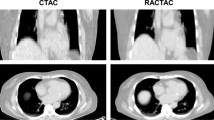Abstract
Background. Reduction of radiation exposure from computed tomography coronary angiography (CTA) will be a key factor for more liberal use in cardiac hybrid positron emission tomography (PET)-computed tomography (CT). We report our initial experience with a new algorithm for low-dose CTA based on a prospectively gated step-and-shoot technique. This limits acquisition to the diastolic phase and minimizes exposure time versus the previous standard of retrospectively gated helical acquisitions.
Methods and Results. In 15 consecutive patients referred for integrated functional and morphologic workup by rubidium 82 perfusion PET-CTA, step-and-shoot CTA (SnapShot Pulse; GE Medical Systems) (120 kV, 600–800 mA) was acquired on a 64-slice GE Discovery Rx VCT PET-CT scanner and compared with a group of patients with conventional helical CTA (120 kV, with modulation of the milliampere level) who were matched with regard to clinical variables. Effective dose was estimated from dose-length product. The American Heart Association 15-segment coronary tree model was used to determine study interpretability. Potential for fusion with Rb-82 perfusion PET was tested by use of commercial software. In addition, direct dose measurements were conducted by use of an anthropomorphic phantom for more accurate dosimetry. The dose-length product-derived effective patient dose for step-and-shoot and helical CTA was 5.5±0.1 mSv versus 20.5±3.5 mSv (P<.0001). The mean number of evaluable segments per patient for the best phase of helical CTA was 12.5±2.8 (83.3%±18.7%) versus 13.3±2.2 (88.7%±14.7%) (P=not significant vs helical) for step-and-shoot CTA. Review of multiple phases increased the number for helical CTA to 13.7±1.7 (91.3%±11.3%;P=not significant vs step-and-shoot CTA, for which this was not an option). Semiautomated fusion with corresponding PET was feasible for all studies. Phantom data confirm effective doses of 5.4 mSv for step-and-shoot CTA and 19.6 mSv for helical acquisition.
Conclusions. Low-dose prospectively gated CTA reduces radiation exposure by nearly 70% versus the previous standard of helical acquisition, without significant loss in interpretability and integrative potential with Rb-82 perfusion PET. This represents a step toward a broader, routine integration of CTA and perfusion PET for assessment of coronary morphology and physiology by cardiac PET-CT.
Similar content being viewed by others
References
Di Carli MF, Hachamovitch R. New technology for noninvasive evaluation of coronary artery disease. Circulation 2007;115:1464–80.
Berman DS, Hachamovitch R, Shaw LJ, Friedman JD, Hayes SW, Thomson LE, et al. Roles of nuclear cardiology, cardiac computed tomography, and cardiac magnetic resonance: Noninvasive risk stratification and a conceptual framework for the selection of noninvasive imaging tests in patients with known or suspected coronary artery disease. J Nucl Med 2006;47:1107–18.
Dorbala S, Hachamovitch R, Di Carli MF. Myocardial perfusion imaging and multidetector computed tomographic coronary angiography: Appropriate for all patients with suspected coronary artery disease? J Am Coll Cardiol 2006;48:2515–7.
Schuijf JD, van der Wall EE, Bax JJ. Changing paradigm: Atherosclerosis versus ischaemia. Eur J Nucl Med Mol Imaging 2007;34:1–3.
Di Carli MF, Hachamovitch R. Hybrid PET/CT is greater than the sum of its parts. J Nucl Cardiol 2008;15:118–22.
Einstein AJ, Henzlova MJ, Rajagopalan S. Estimating risk of cancer associated with radiation exposure from 64-slice computed tomography coronary angiography. JAMA 2007;298:317–23.
Einstein AJ, Moser KW, Thompson RC, Cerqueira MD, Henzlova MJ. Radiation dose to patients from cardiac diagnostic imaging. Circulation 2007;116:1290–305.
Hsieh J, Londt J, Vass M, Li J, Tang X, Okerlund D. Step-and-shoot data acquisition and reconstruction for cardiac x-ray computed tomography. Med Phys 2006;33:4236–48.
Husmann L, Valenta I, Gaemperli O, Adda O, Treyer V, Wyss CA, et al. Feasibility of low-dose coronary CT angiography: First experience with prospective ECG-gating. Eur Heart J 2008;29:191–7.
Lautamäki R, Brown TL, Merrill J, Bengel FM. CT-based attenuation correction in (82)Rb-myocardial perfusion PET-CT: Incidence of misalignment and effect on regional tracer distribution. Eur J Nucl Med Mol Imaging 2008;35:305–10.
Austen WG, Edwards JE, Frye RL, Gensini GG, Gott VL, Griffith LS, et al. A reporting system on patients evaluated for coronary artery disease. Report of the Ad Hoc Committee for Grading of Coronary Artery Disease, Council on Cardiovascular Surgery, American Heart Association. Circulation 1975;51:5–40.
de Denaro M, Bregant P, Severgnini M, de Guarrini F. In vivo dosimetry for estimation of effective doses in multislice CT coronary angiography. Med Phys 2007;34:3705–10.
Geleijns J, Van Unnik JG, Zoetelief J, Zweers D, Broerse JJ. Comparison of two methods for assessing patient dose from computed tomography. Br J Radiol 1994;67:360–5.
Earls JP, Berman EL, Urban BA, Curry CA, Lane JL, Jennings RS, et al. Prospectively gated transverse coronary CT angiography versus retrospectively gated helical technique: Improved image quality and reduced radiation dose. Radiology 2008;246:742–53.
Di Carli MF, Dorbala S, Meserve J, El Fakhri G, Sitek A, Moore SC. Clinical myocardial perfusion PET/CT. J Nucl Med 2007;48:783–93.
Namdar M, Hany TF, Koepfli P, Siegrist PT, Burger C, Wyss CA, et al. Integrated PET/CT for the assessment of coronary artery disease: A feasibility study. J Nucl Med 2005;46:930–5.
Di Carli MF, Dorbala S, Curillova Z, Kwong RJ, Goldhaber SZ, Rybicki FJ, et al. Relationship between CT coronary angiography and stress perfusion imaging in patients with suspected ischemic heart disease assessed by integrated PET-CT imaging. J Nucl Cardiol 2007;14:799–809.
Brown TL, Merrill J, Volokh L, Bengel FM. Determinants of the response of left ventricular ejection fraction to vasodilator stress in electrocardiographically gated (82)rubidium myocardial perfusion PET. Eur J Nucl Med Mol Imaging 2008;35:336–42.
Dorbala S, Vangala D, Sampson U, Limaye A, Kwong R, Di Carli MF. Value of vasodilator left ventricular ejection fraction reserve in evaluating the magnitude of myocardium at risk and the extent of angiographic coronary artery disease: A 82Rb PET/CT study. J Nucl Med 2007;48:349–58.
Mahesh M, Cody DD. Physics of cardiac imaging with multiple-row detector CT. Radiographics 2007;27:1495–509.
Author information
Authors and Affiliations
Corresponding author
Rights and permissions
About this article
Cite this article
Javadi, M., Mahesh, M., McBride, G. et al. Lowering radiation dose for integrated assessment of coronary morphology and physiology: First experience with step-and-shoot CT angiography in a rubidium 82 PET-CT protocol. J Nucl Cardiol 15, 783–790 (2008). https://doi.org/10.1007/BF03007359
Received:
Revised:
Issue Date:
DOI: https://doi.org/10.1007/BF03007359




